Corsair Carbide 200R Case Review: How Low Can You Go
by Dustin Sklavos on December 15, 2012 12:01 AM EST- Posted in
- Cases/Cooling/PSUs
- Corsair
- mid-tower
Noise and Thermal Testing, Stock
When testing something like the Corsair Carbide 200R that sells for just $49, expectations need to be adjusted. While cases above the $150 mark should be expected to provide both excellent cooling and excellent acoustics, a case like the 200R is mostly just expected to "get the job done." The goal is a tougher balance of noise, thermals, and overall build quality; we're just looking to maximize value here.
Ambient temperature during testing was between 22C and 23C.
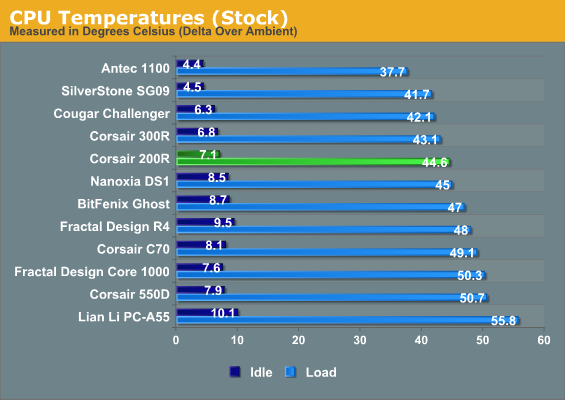
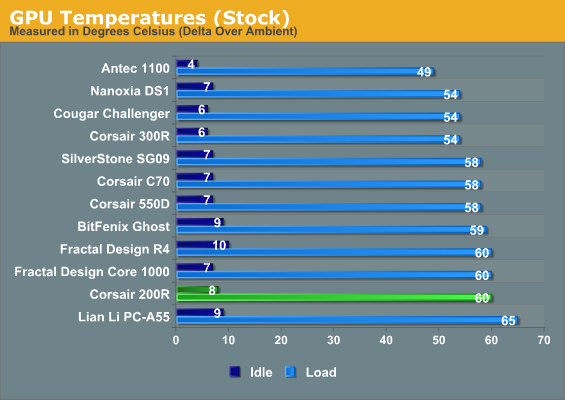
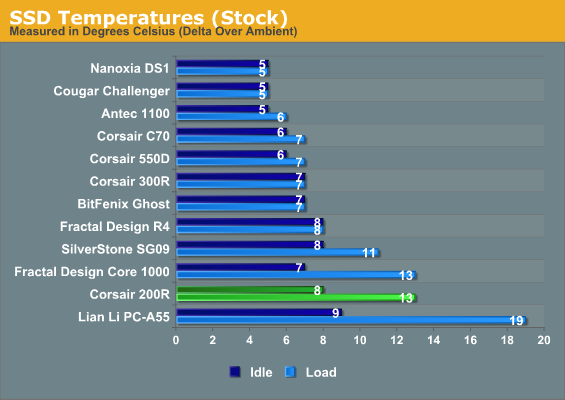
The 200D offers good cooling for the CPU, but the direct intake on the GTX 560 Ti in our testbed just doesn't seem to work out as well as we'd hope. Honestly I'd be surprised if there wasn't some kind of issue with turbulence. The 200D is actually fairly competitive if you really look at the numbers, though.
On the other hand, SSD heat is a surprisingly serious issue, and I suspect that has at least something to do with the plastic cage design. Plastic does a pretty terrible job of dissipating heat, making me increasingly skeptical of a drive cage which will both pack drives together fairly densely and likely trap heat inside the cluster.

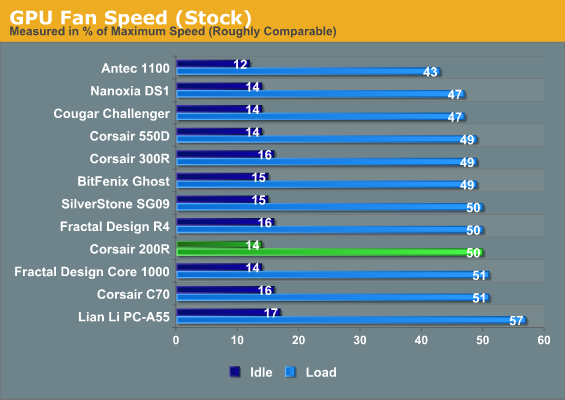
Fan speeds aren't exciting, but they're at least competitive, which is all you can ask for.
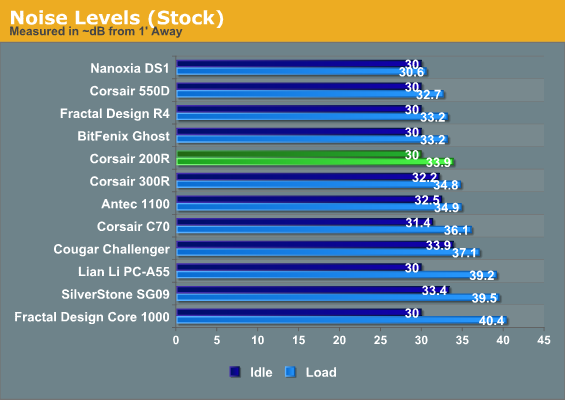
On the other hand, noise levels are surprisingly good for such an open design. The Carbide 200R does a fair job of keeping the components cool along with a fair job of keeping them quiet.
The closest competitor on all of these charts for the 200R is the Fractal Design Core 1000, and in each test the 200R at least meets the Core 1000's performance if not outright beating it entirely.










25 Comments
View All Comments
VTArbyP - Sunday, December 16, 2012 - link
Why has no one commented on the drive cage problems before me?The problem with removing the box from the 3.5' cage, sounds very familiar. I've had similar breakages numerous times in many things that I've had to put together. Usually I find that I missed some key instruction on HOW to remove the offending item without breakage. I still remember the feelings of "Ahh" and utter stupidity, when I found out how to open CD cases! :-) Is the cage removable? Can it be expanded in useful ways without destruction? I'd love to hear from the manufacturer and other builders using this case, since I like its looks and price.
I can't get a good look at the 2.5" case with the pictures shown, but it doesn't look too enclosed. It seems to be just below the front fan and I wonder what effect that has. I would like some close up pictures of it added to the gallery. I feel the itch to drill or saw holes in it for cooling. Perhaps one could direct a bit more of the fan's air through it too. Wonder what would happen if the second front fan was added, slow speed, too cool the drives and perhaps the GPU. The case LOOKs sensibly laid out for cooling the SSDs and GPU, too bad it didn't actually do it, especially since the CPU temps were quite acceptable.
billcat1447 - Sunday, December 16, 2012 - link
I got a new case, a smaller one and it had removable harddrive cages.While nice because it was the only way to put my video card in they didn't think it though very well. It left me with 2 slots while I removed 4. I could have removed 3 and left 3 and it would have worked a lot better and even could have removed just 2 and still got it too work. I had to buy mounting hardware to fit them to the full size mounts. Very stupid.
I kind of like top fans because this is where most of the case heat ends up and so you can remove most with the lest effort. Computer cases are not cup holders and shouldn't have drinks put on them in the first place and is a non issue with me. I like well thought out cases with room enough to run power and other cables behind the motherboard to clean out the mess they can make.
I notice that some cases with USB plugs are about as cheap as they get and just bumping them can ruin them. I would prefer they be mounted in a spot where you can't bump into them and/or made better or stronger. The Cooler Master HAF cases have very very cheap USB plugs in the front of their cases. Other than that they are very good cases. I prefer the power supply on the bottom with the fan hole facing up so dust isn't sucked into them from the floor. They are kind of a vacuum cleaner if you mount the fan down. But this is a personal pref. I think the case is overall cleaner if they are mounted on the bottom if you can put the cabled behind the motherboard space. Makes it easire to get at heatsink for cpu and the motherboard is easier to deal with also. But again, personal preference.
OVerLoRDI - Tuesday, December 18, 2012 - link
I have a 200R with 4 hard drives in the cage. I found the cage assembly decent, sure it isn't as robust as other options, but just being a little careful I didn't run into any of the problems you did.You also have the option to pop off the front of the case and move the fan down so it is blowing into the cage. I'm not sure why it isn't there by default, but that helps a lot with the cage temps.
That being said my 4 drives are a bit toasty in there, but all within spec.
Uthor - Friday, March 8, 2013 - link
For what it's worth, I got this case today and had absolutely no issues removing the accessories box or installing a hard drive. Pulled back the plastic tab on the left side, slid the box out, and slid the drive in. I don't expect to be replacing the drive any time soon, so I also secured it with screws, but didn't feel like I HAD to.DigiMark - Thursday, April 25, 2013 - link
I also purchased this case for use with a Gigabyte Z77X-UP5 ATX mainboard, Corsair TX-series power supply and several 3.5" drives. I found it easy to work with, no sharp edges and a clean look. It sits on the corner of my desk so I don't really have carpet issues, and I really like the power switch with integrated white drive and power lights, works well without being obnoxious. I didn't have a problem removing the hardware cardboard box, but I find that the single left-side latch for each drive does not secure well -- it's easy to push the drive past the holding pin with too much pressure. Once the machine is built is seems tight enough though. I should mention that while I used to build a number of machines using early In-Win cases, this is my first build in 6-7 years and my expectations were low, so also easily met. I think I will take advantage of another commenter's suggestion and move the front-mount fan down to blow past the drive cage. Budget pricing was important to me on this build and I feel like it is a good working case for the price.